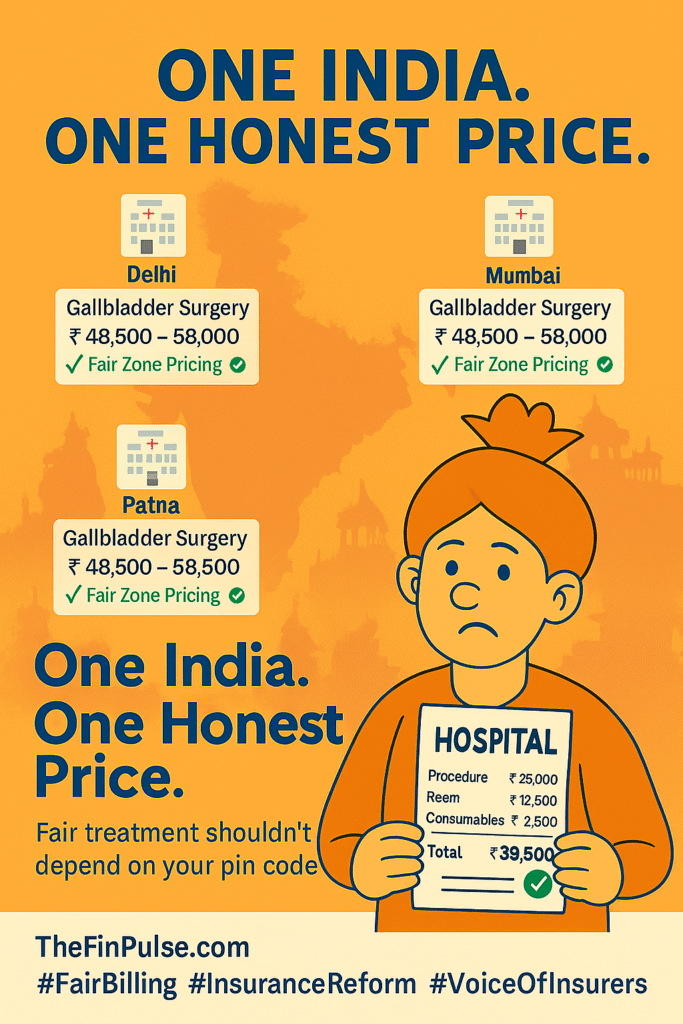
🏥 Hospital Pricing Reform: 5 Powerful Fixes India Needs
Intro: Why This Conversation Matters
After the recent uncovering of India’s hospital billing inconsistencies in our blog “Hospital Bill Scam in India”, the response from industry experts, doctors, and underwriters has made one thing clear — the system is broken for both insurers and patients.
But now it’s time to ask: How do we fix it?
India urgently needs Hospital Pricing Reform — not as a one-time patchwork, but as a sustainable framework rooted in fairness, transparency, and accountability.
Here are 5 powerful fixes that could change the game.
1️⃣ Define a National Pricing Framework with Geo-Categorization
India can’t have the same rates across all cities — that’s unrealistic.
But it can have a tiered pricing framework based on hospital category and location (like Metro, Tier 1, Tier 2, Rural).
Examples exist:
- Tamil Nadu uses a standardized state health package for public hospitals.
- Chhattisgarh categorizes private hospitals based on services and sets prices accordingly.
This kind of hospital pricing reform is both doable and necessary to ensure fairness across geography.
2️⃣ Make Hospital Rate Cards Public via Digital Infrastructure
Let’s leverage India’s growing public digital stack — like the PM-JAY dashboard — to launch a real-time hospital pricing portal.
This portal should:
- Publish hospital rate cards
- Display insurer-hospital MOUs (empanelment rates)
- Allow customers to compare treatment costs city-wise
Such a move would mark a giant leap in hospital pricing reform transparency.
3️⃣ Regulate Out-of-Pocket Medical Expenses
Most Indians still pay medical costs directly from their pockets — over 50%, according to National Health Accounts (2019-20).
This pushes millions into debt each year.
Hospital pricing reform can significantly lower these unplanned burdens, especially for those who aren’t covered under any health insurance scheme.
4️⃣ Involve Civil Society & Patient Advocacy Groups
A reform seen as “just an insurer’s demand” won’t work.
Consumer voices, patient advocacy organizations, and NGOs must be part of the process.
Why? Because they can:
- Flag unfair practices
- Push for ethical pricing
- Represent public interest
Their inclusion makes hospital pricing reform more democratic and acceptable.
5️⃣ Use Real Stories to Drive Policy Change
Data is good, but stories move people.
Here’s one shared in our comment section:
“Hospitals are inflating bills. Insurance companies are absorbing losses quietly, but ultimately premiums go up. It’s not healthcare inflation, it’s corruption.”
— Ankit Goyal, Health Underwriter
Another from a doctor:
“Government must standardize rates by city and hospital category. Or else, patients will continue to suffer.”
— Dr. Shishir Patel, Founder, Patel Hospital
These stories show why hospital pricing reform isn’t optional — it’s urgent.
🗂️ Recent Policy Context: What’s Working, What’s Missing
The Indian government has made notable strides in public health access, but hospital pricing still remains largely unregulated in the private sector.
1️⃣ Ayushman Bharat – PM-JAY
Currently covering 12 crore families with ₹5 lakh per family per year, PM-JAY is a game-changer in public health financing.
👉 However, price control in private hospitals is not standardized, even within PM-JAY.
This blog’s proposal aims to plug that critical regulatory gap through targeted hospital pricing reform.
2️⃣ Affordable Medicines Model
Through initiatives like:
- PMBJP (Pradhan Mantri Bhartiya Janaushadhi Pariyojana), and
- AMRIT (Affordable Medicines and Reliable Implants for Treatment),
medicine prices have dropped by 50% to 80%.
✅ Why not apply the same boldness to hospital pricing reform?
3️⃣ Union Budget 2025–26
The recent budget boosted health allocations — a welcome step.
But there was no move on regulating hospital charges, even though the issue is widely acknowledged.
🟨 In short: Infrastructure is expanding. Insurance coverage is growing.
But without hospital pricing reform, patients and insurers will continue to bleed silently.
💡 Conclusion: Time for One Honest Price
Fairness in healthcare doesn’t begin in ICUs — it begins in pricing.
If India can adopt the mantra of:
🟢 One India. One Honest Price — categorized fairly by geography and hospital type —
then both insurers and patients can breathe a little easier.
It’s not about cutting profits.
It’s about cutting confusion, corruption, and cost shocks.
The system doesn’t need sympathy.
It needs hospital pricing reform — and it needs it now.
🔗 Internal Link:
➡️ Read the blog that started it all: Hospital Bill Scam in India – The Truth Insurers Stay Silent On
